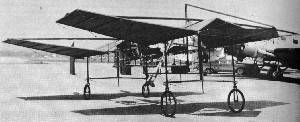|
|
|
 |
|
Inductees
C. C. (Carl) Agar
Raymond Collishaw
W.W. Gibson
Sheldon Luck
Jim Spilsbury
DeHavilland Beaver
Contact Us |
 W.W.(William Wallace) Gibson
In 1910, William Wallace Gibson of Victoria - without
formal training, designed and built the first successful
Canadian aircraft engine.
This truly remarkable achievement, carried out on the
basis of his own experiments, was followed by the design
and construction of two aircraft of advance design.
The first machine, which Gibson called a "Twinplane". had
wings both in front and behind the pilot. Powered by the
inventors engine, the aircraft made a successful flight on
September 8. 1910, flying a distance of 200 feet at a height
of 20 feet.
"The trial was made over the Dean farm in the vicinity of
Mount Tolmie. When he did alight the severe concussion
fractured the riding wheels of the Twinplane and further
flights were delayed for a day or two.In length the
Twinplane measures 54 feet with a width of eight feet,
while the planes [wings] are positioned lengthwise on
the craft and are controlled by a single lever which guides
the course of the airship. The planes measure twenty feet
each in length and are eight feet wide, supplemented with
one hundred springs girded with wire which make the
machine indestructible" -
Regrettably, the publicity that Gibson received led to his
being the object of considerable ridicule around Victoria.
Though somewhat daunted by this reaction he pressed on
and produced a second airplane which was appropriately
called the "Multiplane". A large number of airfoils, which
looked much like Venetian blinds, provided the lift. Using
the same 40-horsepower engine employed earlier in the
Twinplane, Gibson hoped to prove that a new type of
Iifting surface could be equally effective as more
conventional wings.
The aircraft flew on several occasions in 1911.
Moving first to Ladner in the Fraser delta to take
advantage of the flat country, Gibson then transferred
his flying activities to Kamloops and finally Calgary.
By this time, he had given up piloting his own machine
due to his wife s objections, and another pilot was hired.
However, an unscrupulous promoter who was attempting
to profit from Gibson s work soon forced the inventor's
retirement, ending a brief but outstanding career in aviation.
|